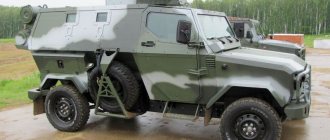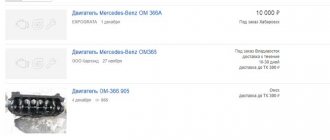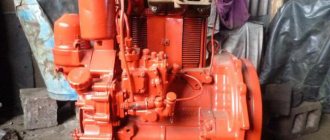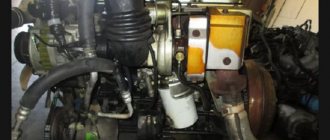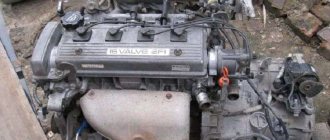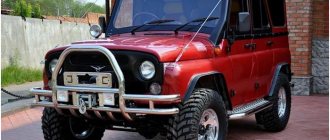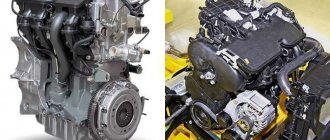Engines Sportage I generation
Kia Sportage debuted in 1993. This is the first and only time the Sportage has had multiple body styles. In addition to the standard five-door version, a three-door with an open top and a car with an extended rear overhang (Sportage Grand) were offered.
The Korean manufacturer created its first SUV based on a Mazda car. The Sportage uses a body-on-frame design. Most of the time, the SUV is rear-wheel drive, the front is rigidly connected.
The engines also came from the Japanese. Under the hood of the Sportage one could find a two-liter gasoline engine in three different versions and two diesel engines: 2.0 and 2.2 liters.
F.E.
Kia began producing ICE series ICEs under Mazda license in 1992. This is a four-cylinder naturally aspirated unit with a cast iron block and an aluminum cylinder head. Before installation in the Sportage, the engine was slightly modified, in particular, the intake receiver was changed, a different camshaft was installed, and the compression ratio was reduced.
There were two versions: with an 8- and 16-valve cylinder head. The first ones could only be found on Korean-assembled cars before 1999. This engine develops only 95 horsepower compared to 118 horsepower of the 16-valve. In addition, it has a record low compression ratio of 8.6.
Starting in 1995, FE-DOHC engines with double camshaft appeared under the hood. The cylinder diameter and piston stroke were left unchanged.
| Engine | FE SOHC (DOHC) 16V |
| Type | Gasoline, naturally aspirated |
| Volume | 1998 cm³ |
| Cylinder diameter | 86 mm |
| Piston stroke | 86 mm |
| Compression ratio | 9.2 |
| Torque | 166 (173) Nm at 4500 rpm. |
| Power | 118 (128) hp |
| Overclocking | 14.7 s |
| Maximum speed | 166 (172) km/h |
| Average consumption | 11.8 l |
R2 and RF
The first generation Sportage was equipped with two diesel engines. One of them is the 2.2 liter R2 without turbocharging. It produces only 63 horsepower and 127 Nm of torque. This power unit could previously be found on the Mazda Bongo minibus. It was installed on Sportage until 2002.
The second engine is a diesel modification of the FE series unit. The block itself has not undergone any changes, but the cylinder head is completely different. The Korean designers themselves added a turbine to it, thanks to which the power increased to 83 horses. In terms of reliability, this engine is less preferable than gasoline engines. A diesel engine operates under a greater load, plus it has a more complex design (pre-chamber ignition, turbine, intercooler).
| Engine | RF |
| Type | Diesel, turbocharged |
| Volume | 1998 cm³ |
| Cylinder diameter | 86 mm |
| Piston stroke | 86 mm |
| Compression ratio | 21 |
| Torque | 193 Nm at 4500 rpm. |
| Power | 85 hp |
| Overclocking | 20.5 s |
| Maximum speed | 145 km/h |
| Average consumption | 9.1 l |
Generation II Sportage engines
In 2004, a generational change occurred. And at the same time, the concept of the car itself has changed. The Sportage has ceased to be a frame SUV, moving into the crossover class. It is based on the new monocoque body and platform of the Elantra.
G4GC
The most common engine in the second-generation Sportage was the two-liter gasoline “four”. This is a simple and unpretentious unit. Cast iron block, aluminum cylinder head. The timing belt has a timing belt that needs to be changed every 50-70 thousand to avoid breakage and damage to the valves on the cylinders. There is one phase shifter installed in the head, which changes the phase angles of the intake valves.
But due to the lack of hydraulic compensators, valve clearances need to be adjusted every 90 thousand km.
| Engine | G4GC |
| Type | Gasoline, naturally aspirated |
| Volume | 1975 cm³ |
| Cylinder diameter | 82 mm |
| Piston stroke | 93.5 mm |
| Compression ratio | 10.1 |
| Torque | 184 Nm at 4500 rpm. |
| Power | 141 hp |
| Overclocking | 11.3 s |
| Maximum speed | 176 |
| Average consumption | 9.3 |
D4EA
There are two modifications of the D4EA motor. They differ only in the turbine and attachments. The younger version uses WGT supercharging and produces 112 horsepower. A more powerful modification uses a VGT turbine and another injection pump with increased performance. The engine is considered quite reliable, but expensive components and considerable age of the cars make the purchase of second-generation diesel Sportage a risky proposition.
| Engine | D4EA |
| Type | Diesel, turbocharged |
| Volume | 1991 cm³ |
| Cylinder diameter | 83 mm |
| Piston stroke | 92 mm |
| Compression ratio | 17.3 |
| Torque | 246 (305) Nm at 1800 rpm. |
| Power | 112 (140) hp |
| Overclocking | 16.1 (11.1) s |
| Maximum speed | 167 (178) |
| Average consumption | 7 |
G6BA
The top engine of the second generation Sportage is a 2.7 liter V6. This engine was only available with a 4-speed automatic transmission and all-wheel drive. Its features include an aluminum block and cylinder head and a small piston stroke. Hydraulic compensators are installed, but there is no phase change system.
It is advisable to change the timing belt in advance; if it breaks, the pistons bend the valves.
| Engine | G6BA |
| Type | Gasoline, naturally aspirated |
| Volume | 2656 cm³ |
| Cylinder diameter | 86.7 mm |
| Piston stroke | 75 mm |
| Compression ratio | 10.1 |
| Torque | 250 Nm at 4000 rpm. |
| Power | 175 hp |
| Overclocking | 10 s |
| Maximum speed | 180 |
| Average consumption | 10 |
Features of Kia Sportage 3
Like other competitors in the class, the Kia Sportage 3 was sold with both front-wheel drive and rear wheel drive using an electromagnetic clutch. Standard configurations were equipped with a 5 or 6-speed manual transmission, all others were equipped with only a 6-speed automatic transmission.
While the driver is driving alone in the car, the model copes well with the chassis. But when the cabin is busy, the situation is completely different. The already fairly dense suspension ceases to neutralize road surface defects. The body shakes on bumps, which responds in the steering wheel (especially noticeable if low-profile tires are installed). The steering isn't particularly colorful, but the crossover handles well.
Generation III Sportage engines
The third generation was released in 2010. The crossover received a bright and dynamic design, in which there was not a hint of the calm appearance of its predecessors. Like the Sportage 2, the new car had front-wheel drive as standard. All-wheel drive is available for an additional fee, but its task is not to increase cross-country ability; after all, the crossover has become purely asphalt, but to make behavior on slippery types of surfaces more confident.
G4KD
G4KD is a two-liter gasoline engine. It was found most often on the Sportage and was the only gasoline engine in the lineup. There were frequent complaints about this motor related to noisy operation. Diesel sound on a cold engine indicates scoring on the cylinder walls. Whirling is a feature of the operation of injectors.
After restyling in 2014, instead of the G4KD engine, they began to install the G4NU engine. It differs in block geometry and timing drive.
| Engine | G4KD |
| Type | Gasoline, naturally aspirated |
| Volume | 1998 cm³ |
| Cylinder diameter | 86 mm |
| Piston stroke | 86 mm |
| Compression ratio | 10.5 |
| Torque | 197 Nm at 4600 rpm. |
| Power | 150 hp |
| Overclocking | 10.7 s |
| Maximum speed | 182 |
| Average consumption | 7.6 |
D4FD
The 1.7 liter diesel engine is the D4FD engine, which was introduced only in 2010. This is the largest engine in the new U series of Hyundai units. It is equipped with a timing chain drive, two camshafts, each with a phase regulator. In addition, a VGT turbine with variable geometry is installed.
There are two versions of this engine. On Sportage, only the least powerful one is used with a return of 115 horses. This engine is sensitive to fuel quality. Low-grade diesel fuel quickly damages the injectors, causing engine performance to become uneven.
If traction is lost and jerking appears, then most likely the fine or coarse filters are clogged.
| Engine | G4KD |
| Type | Gasoline, naturally aspirated |
| Volume | 1998 cm³ |
| Cylinder diameter | 86 mm |
| Piston stroke | 86 mm |
| Compression ratio | 10.5 |
| Torque | 197 Nm at 4600 rpm. |
| Power | 150 hp |
| Overclocking | 10.7 s |
| Maximum speed | 182 |
| Average consumption | 7.6 |
D4HA
A two-liter diesel engine appeared in 2009. Unlike the 1.7 liter engine, its block is cast from aluminum, not cast iron. The timing drive uses a chain. Hydraulic compensators independently regulate valve clearances. The boost system uses a variable geometry turbine. Just like the younger diesel engine D4HA, it is demanding on fuel quality. In addition, during dynamic driving at high speeds, a small oil consumption occurs; it is advisable to monitor its level.
The D4HA engine has two versions: standard and boosted to 184 horses. Both can be found under the hood of the Sportage.
| Engine | D4HA |
| Type | Diesel, turbocharged |
| Volume | 1995 cm³ |
| Cylinder diameter | 84 mm |
| Piston stroke | 90 mm |
| Compression ratio | 16.5 |
| Torque | 373 (392) Nm at 1800 rpm. |
| Power | 136 (184) hp |
| Overclocking | 12.1 (9.8) s |
| Maximum speed | 180 (195) |
| Average consumption | 6,9 (7,1) |
7i V6 (G6BA)
The flagship six-cylinder unit shares many design features with the two-liter engine. Among them is a combined timing drive.
One of the unpleasant features is the design of the hydraulic belt tensioner. It didn't turn out very well. During winter starts, when the oil loses its viscosity, it may slip.
Problems often arise with intake flaps and exhaust manifolds. The catalytic collectors also do not have sufficient resources. In addition, there are two of them on this engine.
The engine block is made of aluminum, but with cast iron liners. It has simply an excellent resource by modern standards. With proper timely maintenance, it can last up to 400-500 thousand km.
Generation IV Sportage engines
The fourth generation of Kia Sportage arrived in Russia in 2021, six months after the official premiere in Frankfurt. Technically, the car has not changed much; the crossover is built on a modified platform of its predecessor and inherited the engines from it. For example, the diesel engine migrated from under the hood of the Sportage 3 without any changes at all.
G4NA
The base engine for the Sportage is still a 2-liter inline four-cylinder. The new unit is designated G4NA and belongs to the Nu family, which was introduced in 2010. Following modern trends, the designers preferred an aluminum block and cylinder head. Both camshafts have phase shifters for better filling of the cylinders at different speeds.
Hydraulic compensators are also provided; they will eliminate the need for manual valve adjustment every 90 thousand km. The timing belt uses a chain.
| Engine | G4GC |
| Type | Gasoline, naturally aspirated |
| Volume | 1999 cm³ |
| Cylinder diameter | 81 mm |
| Piston stroke | 97 mm |
| Compression ratio | 10.3 |
| Torque | 192 Nm at 4000 rpm. |
| Power | 150 hp |
| Overclocking | 11.1 s |
| Maximum speed | 184 |
| Average consumption | 8.2 |
G4FJ
The only truly new unit is the petrol turbo-four. Fashionable downsizing has also reached the Kia crossover. This 1.6-liter engine produces 177 horsepower, which is 27 horsepower more than its two-liter gasoline counterpart. In addition to the turbine, they are distinguished by a fuel supply system. The G4FJ uses direct injection. The CVVT phase control system is available on both the intake and exhaust shafts.
Hydraulic compensators are not provided; the valves must be manually adjusted every 90 thousand km. Timing chain drive. From the factory there are three versions of different power: 177, 186 and 204 horsepower.
Much of the credit for the improved dynamics goes to the new dual-clutch robotic transmission. A turbocharged engine is available only in combination with it and all-wheel drive.
| Engine | G4FJ |
| Type | Petrol, turbocharged |
| Volume | 1591 cm³ |
| Cylinder diameter | 77 mm |
| Piston stroke | 85.4 mm |
| Compression ratio | 10 |
| Torque | 265 Nm at 1500-4500 rpm. |
| Power | 177 hp |
| Overclocking | 9.1 s |
| Maximum speed | 201 |
| Average consumption | 7.5 |
Kia Sportage engines
| Sportage I | Sportage II | Sportage III | Sportage IV | |
| Engines | 2 | 2 | 2 | 2 |
| F.E. | G4GC | G4KD/G4NU | G4NA | |
| 2.2d | 2.7 | 1.7d | 1.6t | |
| R2 | G6BA | D4FD | G4FJ | |
| 2.0d | 2.0d | 2.0d | 2.0d | |
| RF | D4EA | D4HA | D4HA |
The example of the Kia Sportage clearly shows how engines are developing. From unpretentious units of simple design, which produced little power and consumed a lot of fuel, evolution gradually comes to more efficient and complex internal combustion engines with a shorter resource.

